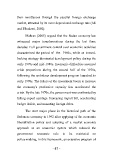Page 535 - 2016 - Vol. 40
P. 535
their remittances through the parallel foreign exchange
market, attracted by its more depreciated exchange rate (Ali
and Elbadawi, 2002).
Mahran (2005) argued that the Sudan economy has
witnessed major transformations during the last three
decades. Full government control over economic activities
characterized the period of the 1960s, while an inward-
looking strategy dominated development policy during the
early 1970s and mid-1980s. Economic difficulties assumed
crisis proportions during the second half of the 1970s,
following the ambitious development program launched in
early 1970s. The failure of the investment boom to increase
the economy's productive capacity has accelerated the
crisis. By the late 1970s, the government was confronted by
falling export earnings. Increasing import bill, accelerating
budget deficit, and mounting foreign debts.
The start major phase in the historical path of the
Sudanese economy in 1992 after applying of the economic
liberalization policy and adopting of a market economy
approach as an economic system which reduced the
government economic role to be restricted on
policy-making, in this framework, an extensive program of
- 47 -

